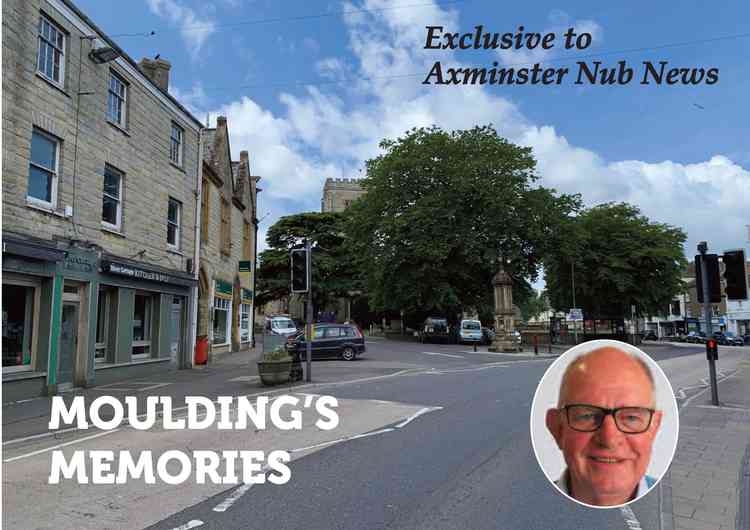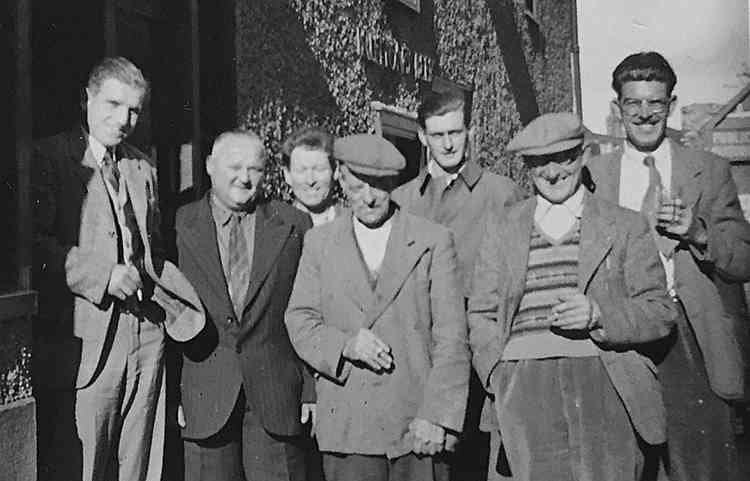The streets of Axminster in the 1950s
By Philip Evans
13th Jul 2020 | Local News


My early years' memories were characterised by the streets of my town, whilst walking to school, shopping with my mother, going to Sunday School or the cricket field. We walked everywhere, as my father was in the RAF in Weston-super-Mare, he had the car – no two-car families in the 1950s; very few ladies drove in those days!
I propose to take a walk around the town and look at the streets and businesses that I remember. Please let me know if my memory plays tricks on me!
We lived in Castle Street, right opposite the Phoenix pub, which my father ventured into when home at weekends. Below the Phoenix and a few cottages, John Rowe opened his garage in the early 1950s, assisted by his wife Molly – one of the few businesses in Axminster, still operated by the same family - as John's son Nigel continues to run the garage.
Opposite John Rowe's Garage in Castle Street was the old Wesleyan Methodist Chapel. I can't remember this lovely three-storey brick building operating as a place of worship. As far as I can remember, it was a "sale-room" in the 1950s and is still an Antiques and Collectables Centre.
I believe Mr Harold Bolton bought the building and Donald Thomas ran the sale-room. Eventually it was let to a non-conformist organisation, who left and went to Weycroft, when the building became an Antiques Centre once more.
Beyond the steps, now called "Symes Lane", were the public toilets – still there, but unused!
There's a strange gap adjacent to the public loos, known as Jeff's Patch as Lord Jeff (see later) used to maintain a small garden, with access above from Market Square. Then, there was "The Clink", a small 'room' within the retaining wall along Castle Street which is thought to have functioned as the town "lock-up" between circa 1600 and 1800. In the early 1950s, as a child, it was a place that I kept well clear of!
Towards the end of Castle Street, I seem to remember a greengrocers on one side of the road and a small Co-op on the junction of Castle Street and Castle Hill.
Going down Castle Hill on the southern side, we then come to Mr Duke's shop, a convenience store, run by Mr Len Duke, a former chairman of Axminster Rural District Council. He may have served as chairman of the council, but all I remember Mr Duke serving, was fabulous ice-cream!
Further down Castle Hill, we come to Vale Lane – in the fifties, it was "Gas Lane" – as that was where the gas works was sited. Beside the gas works was the Tar Works, as a bi-product of the Gas Works. My accomplice John Jeffery reminds me that the Gas Works was run by Mr Bill Couch and the Tar Works by a Mr Moore.
The discovery of North Sea gas and the ability to store gas in high-pressure pipes underground, meant that gas holders were no longer needed and the one in Gas Lane was eventually removed.
However, right alongside was a concrete structure, formed from the works chimney, known as "Chimney Corner", which always stayed warm, even in winter. My father reckoned that this was the best place in Axminster for courting – warm and dry!!
Beyond chimney corner was Valley Path, still one of the most popular places in Axminster for dog walking. I well remember looking for eels, sticklebacks and an occasional trout in the Mill Leat, which runs alongside.
Back up Vale Lane and over Ducking Stool Bridge, we come to one of the most thriving businesses in Axminster at that time, Norringtons – Agricultural Engineers and Fordson Tractor Agency, which operated on both sides of the railway line. When you crossed the line, inevitably there would be a train coming! No automatic level crossings then. You would hear the bell, watch the signals and wait for Lionel Reed to open the gates.
Norringtons was based in Exeter, but the Axminster depot manager was the redoubtable Herbert Jeffery, "Lord Jeff of Ducking Stool Bridge", a character of Axminster, advocate for Old Time Music Hall and a friend to all. (Not much different to his son John Jeffery, although I've not seen John with his spats on, tripping the light fantastic!)
Across the road from Norringtons was Bidwells Brush Factory, which in the mid nineteenth century employed about 300 Axminster people. The factory was initially operated by a Mr Coate from Membury, but eventually taken over by the Bidwell brothers, with a much reduced labour force. The business all-but closed in the mid 1950s.
There was a 10-foot wide water-wheel beyond Ducking-stool bridge which powered the brush works and the mill, then occupied by Norringtons.
Alongside the Brush factory was the Sackworks owned by Colonel Tissington, which closed about the same time as the Brush Factory.
Back towards town and at the bottom of Castle Hill was the Green Dragon public house, run at that time by Mrs Guest. Strangely, in my youth, that was one of the few pubs in the area that I didn't frequent.
Coming up Castle hill on the northern side, we had Mrs Hawkins Sweet Shop (a jewel in the crown for us small children) and George Rice's Bicycle Shop. At the top of Castle Hill, until it was demolished for the new entrance road to North Street, there was Carter's Boot and Shoe Repair Shop, which was on the site of the former Black Lion public house.
Access to North Street was formerly via what is now known as Old North Street, where in the Autumn I would collect myriads of conkers, fallen from the huge horse chestnut tree in the garden, belonging to Mr Jack Gill at Castle Mount, one of many listed buildings in Axminster. (As a matter of interest, I learnt recently that for its size, Axminster has more listed buildings than any other town in Devon).
Walking past Kingdom Hall, the worship centre for the Jehovah Witnesses in Axminster, I would then come across the Fire Station, which was sited at the top of the North Street Playing Field, which in the 1950s, before the new road into North Street was built, came right up to the back of the Fire Station.
From my home in Castle Street, I would hear the fire siren alarm sound, and I would chase round to the Fire Station, to see the volunteer fireman climb up onto the fire engine and out on a call.
North Street was a regular walk for me in the 1950s as it led to the cricket-field, where I spent countless hours, initially watching my father play cricket and later playing and practising myself.
Access to the field was via a small pedestrian walkway at the end of Albert Terrace, which led to the cricket pavilion and opened up into the picturesque cricket field. The cricket playing area was bordered by a paddock, which is now Willhayes Park, the railway line to the west, Mr Cawley's lovely bungalow to the north and Axe Vale Laundry between the cricket field and North Street. The Laundry was a thriving business for the Cawley family in the 1950's, but through the introduction of washing machines and tumble driers, business declined until the laundry closed in the 1980's.
My father had an allotment at the end of North Street and he would urge me to assist. Picking fresh veg was OK, but weeding was something I tried to avoid and would sneak off back to the cricket field, or in the autumn I would be finding more conkers on the horse chestnut tree on Cloakham Drive.
My father and I would also wander up to Cloakham Bridge, just to look at the winding River Axe, where my angling father would be straining his eyes, looking into the river for roach, dace or the occasional trout.
Coming back up North Street and returning to Castle Hill we come to the Castle Inn, which was one of several pubs owned by the Carr & Quick's, Exeter-based brewery. I believe the tenant at that time was a Mr Reynolds.
On the opposite side of the road is Gloucester House, another listed building, which was then occupied by my dentist, Mr Prescott, where I regularly had an "appointment with fear"! I'm only joking, as Mr Prescott as a delightful man and a first class dentist.
Touch wood, at 74 years old, I have very few problems with my teeth and put that down to the first class dental work I received from Mr Prescott and his successor, Mr Keith Barton, when I was a boy. Those were the days when you didn't have an injection for a filling – the drill kept grinding away and if it touched a nerve, you nearly hit the ceiling! When a tooth was removed you were knocked out via a nitrous oxide gas mask. When you had a tooth removed by Mr Prescott, he always gave you sixpence for an ice-cream from Mr Duke down the hill.
Above Gloucester House is the Regent Hall, on the site of the original Axminster market-place. The building eventually housed the Regent Cinema, closed in the 1930s. When I was a lad, it was all part of W G Potter's furniture store.
Crossing Market Square, on the corner, now used as the taxi office, was Mr Hoy's butcher's shop. At that time, I remember Wally Hoy as an archetypal butcher, slightly rotund, looking as if he enjoyed his own sausages! Hoy's was one of several butchers in the town at that time.
Next to Hoy's butchers was Trump's Stores, grocers – later to be International Stores, prior to John Lambert taking over. Trump's Stores was run by Mr Hitchcock, whose daughter Ann, was in the same class as me at Primary School. It was a typical local grocers and whenever I went in, it had that lovely aroma of freshly ground coffee.
Across the road in Victoria Place, was Castle Mount House, another Grade II listed building and adjacent was the emporium of Edwin Dawkins and Sons, probably at that time, the best department store in East Devon. The owner was Miss Sheppard, an enchanting lady, always smartly dressed and never without a hat! The shop had a treasure trove of goods from clothing, boots and shoes, ironmongery, haberdashery, kitchenware and toys.
I still remember some of the shop assistants: Tommy Pascoe, Phyl Cornish, Betty Swain (I'm sure you will remember more?) But what I remember most about Dawkins, was the pneumatic tube system which propelled cylindrical brass containers around the store, which carried sales slips and money, from the salesperson to the cashier's desk. It was a great system and I relished in seeing the few pence I had spent in the toy department, being popped into the brass cylinder, zooming around the ceiling and landing up at the cash desk. The game was to see if you could run from the department and get to the cashier before the money arrived there!
Just up the road in Chard Street, was a brick built residential property called Elson House, another listed building, which in later years my wife and I bought and upgraded. I changed the name from Elson House to Hanover House, as someone suggested that it sounded as if we lived in a toilet!
Just above Elson House and Home Lea in Chard Street was Gill's Bakery, where the Gill family had baked for many years. They also ran Gill's Café in Trinity Square, so it was quite an operation to prepare all the food in Chard Street and carry it down to the café in the Square. Further up Chard Road, we find Oak House, another fine red-brick building, which when I was a child was the offices of the Rural District Council. (Have a look at the parapet of the building and you will see two cherubs. A certain decorator in town (who will be nameless) assigned with the painting of Oak House, gathered considerable criticism for painting the cherubs' bare appendages in bright red! Immediately above Oak House was the Cottage Hospital, where my first memory was having my tonsils removed. A matron I remember in those early years was Miss Joan Sharp, but I have recollections of another matron before Miss Sharp, but I don't seem to remember her name? Just over the road from the Hospital was Hilary House, the original home of the Knight family. As a youngster, I remember the house having a lovely lawn, where garden parties and fetes were held. There was always a rumour that the house was haunted and my father always told me that the property was "riddled" with dry rot! Coming back down Chard road and past the entrance to the secondary school, the next building was the Congregational Church School Room, where my Uncle Fred Moulding taught at some of the Sunday School sessions. This building was formerly the original Congregational Church, built in the seventeenth century and was then superseded by a new church, later to become the United Reformed Church. The next building below the church was the former British Legion Club (later to be the Axe Vale Social Club), recently made famous as it became a massive cannabis farm, one of the largest hauls of the cannabis drug found in Devon. Below the Legion Club was the pedestrian entrance to the secondary school and then Surridge Dawsons, a newspaper and magazine distribution company, always recognised by the small concrete steps and handrail, which led up to the entrance door of the building. When we lived in Elson House, we were occasionally woken up at about 4.00 am, with a hive of activity at Surridge Dawsons, as the newspaper delivery business demanded an early start. The business closed in the early 2000's. Next in Chard Street was Scott Rowe Solicitors, established in the late eighteenth century. The senior solicitor in the 1950s was Daniel Scott Rowe, who I remember officiating at carnival events and very much involved in town affairs. Adjacent to Scott Rowe solicitors was Philip Hicks opticians, where as a youngster of about eight years old, I attended for spectacles to be fitted for my short-sightedness. The building is characterised by the lovely curved small-paned windows which still remain, under the following eras of Batemans and Vision Express. Around the corner of Chard Street and George Street was another ladies and gents outfitters, run by the McNeil family – I remember Don, Phyllis and Arthur McNeil, together with Arthur's daughter Anne, who married one of my employees, Mr Bill Goddard. McNeil's was a friendly store, much smaller than Dawkins but my mother seemed to frequent McNeil's, just as much as Dawkins. Just beyond Pig Lane, is Pulman House, the former home of George Pulman, the founder of Pulman's Weekly News. This imposing building, now divided into a number of separate units, sits on the junction of George Street and Lyme Street. I remember the building as Graham Newbery's Electrical shop, as I was friendly with Graham Newbery's two sons, Roger and Melvyn, who were at school with me. I also remember Graham Newbery's wife, Eve Newbery, who was a keen supporter of everything Axminster! I WILL CONTINUE MY WALK AROUND THE STREETS OF AXMINSTER IN THE 1950s, IN THE NEXT EDITION OF MOULDING'S MEMORIES
New axminster Jobs Section Launched!!
Vacancies updated hourly!!
Click here: axminster jobs
Share:


